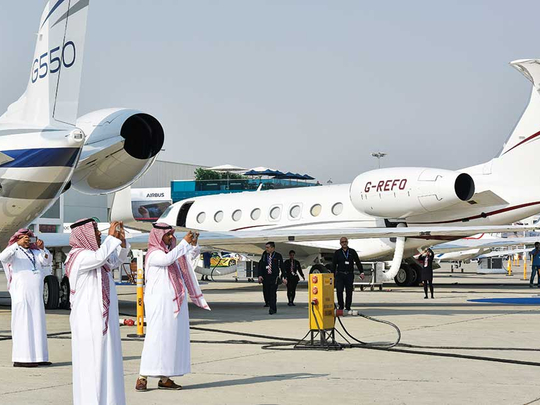
Dubai: The world of fast-paced corporate aviation is on the rise in the Middle East, driven predominantly by the UAE and Saudi Arabia, where it is reportedly common to travel by private jet from city to city within the kingdom.
Once driven by the lucrative oil and gas sector and government officials, the business jet segment, as it’s commonly known, is now populated by business executives from new industries, principally health care and finance.
“There is a really high demand, especially for mid-sized jets, in the Middle East. Customers here are really looking for aircraft that can seat eight to nineteen passengers,” said Ghada Fawzi, director of sales for Falcon Aviation, which charters corporate jets and helicopters.
She added that the company’s studies suggested that the business jet market would increase by 15 to 17 per cent in 2018 in overall sales.
The global business jets market was worth $20.9 billion in 2013 and is projected to grow at a CAGR (compound annual growth rate) of close to 7 per cent to $33.8 billion by the end of 2020, according to research firm Research and Markets.
Their report, released in 2016, highlighted how Saudi Arabia was leading the way in the region, with the biggest fleet of business jets in the Middle East at 188 aircraft, followed by Turkey at 157 and the UAE at 135.
“The key player in this has always been Saudi Arabia,” said Fawzi, adding: “They are the major player in the market. They even use these private jets to fly domestically.”
Fawzi noted that the demand for business jet services was also high in the UAE.
According to the head of sales for Sky Prime Aviation Services, a Saudi-based corporate aviation services provider, the kingdom makes up 80 per cent of the private aviation market in the Gulf region.
“For private aviation in particular, Saudi is fast becoming a hub … we forecast this will continue and expand throughout 2018,” the spokesperson said.
Part of this growth is due to the reduced rates businesses now need to pay for the luxury of flying private.
The volume and variety of jets on offer through a large number of different operators have seen rates fall, making business jets (relatively) more affordable.
“The rates have improved dramatically due to the variety of products in the market. The market is now flooded with products,” Fawzi said.
These lower rates have increase demand across the Gulf, she added.
For example, VistaJet, which operates a fleet of over 70 corporate jets, say that their customers have grown by 50 per cent in the Middle East this year alone.
So where are these new customers coming from?
Well, one place they’re not coming from, say industry executives, is the oil and gas sector, which has dried up as a source of revenue since the price of oil fell sharply three years ago and oil companies adopted aggressive cost-cutting programmes.
According to those executives, whilst weathly families and government officials remain reliable sources of business, a large portion of the industry’s new revenue is coming from corporate sectors such as banking, finance, and health care.
Another driver of growth is the arrival of international businesspeople who are visiting Dubai, looking to expand their business to the region.
“We’re seeing many private jets coming from different parts of the world. Many African owners fly to Dubai, for example. It’s not just those based here in the region, it’s those coming from outside the Middle East, and who want to establish bases in Dubai. These come from the CIS countries such as Ukraine and Kazakhstan, Africa, and Europe too,” said Adel Mardini, CEO of Jetex, a Dubai-based trip planning and aircraft handling company.
Overall, Mardini said, he was very confident in the market, and optimistic about the future of corporate aviation in the Gulf region.










